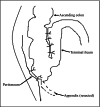Surgical treatment of recurrent intussusception induced by intestinal lymphoid hyperplasia in a child: is bowel resection always necessary? A case report
- PMID: 35538469
- PMCID: PMC9092808
- DOI: 10.1186/s12893-022-01608-w
Surgical treatment of recurrent intussusception induced by intestinal lymphoid hyperplasia in a child: is bowel resection always necessary? A case report
Abstract
Background: Intussusception recurrence (IR) induced by intestinal lymphoid hyperplasia (ILH) in children is rare, and surgical treatment is the final resort if IR is refractory to medications and non-surgical interventions. To date, only a few case reports have described surgical management of ILH-induced IR in children, all involving bowel resection regardless of whether there are bowel necrosis and perforation.
Case presentation: A 2-year-old boy was transferred to our department due to IR. His main complaint was abdominal pain. Color Doppler ultrasound confirmed ileocecal intussusception while no other abnormalities were found. A final diagnosis of IR with unknown causes was made. Repeated saline enema reductions and dexamethasone failed to cure the IR. Laparotomy was eventually performed after almost 10 episodes of IR. Intraoperatively, distal ileum thickening with palpable masses without bowel necrosis and perforation was noted. ILH was suspected and a biopsy of the affected intestine was performed. Histopathological analysis confirmed ILH. The intussusception was manually reduced, the terminal ileum and the ileocecal junction were fixed to the paralleled ascending colon and the posterior peritoneum respectively, and no bowel resection was performed. The postoperative recovery was uneventful and no IR was observed during over 5 years of follow-up.
Conclusions: As far as we are aware, this is the first report of successful surgical treatment of ILH-induced pediatric IR without bowel resection in a child. Our experience suggests bowel resection may be unnecessary if bowel necrosis and perforation are absent.
Keywords: Bowel resection; Case report; Enema reduction; Intestinal lymphoid hyperplasia; Intussusception recurrence.
© 2022. The Author(s).
Conflict of interest statement
The authors have no competing interests.
Figures




Similar articles
-
Colonoscopic diagnosis of lymphoid hyperplasia causing recurrent intussusception: report of a case.Surg Today. 1998;28(3):301-4. doi: 10.1007/s005950050126. Surg Today. 1998. PMID: 9548314
-
[Oral corticosteroids are efficient in recurrent intussusception associated with intestinal lymphoid hyperplasia].Arch Pediatr. 2008 Sep;15(9):1420-2. doi: 10.1016/j.arcped.2008.05.004. Epub 2008 Aug 3. Arch Pediatr. 2008. PMID: 18676125 French.
-
Characteristics of intestinal-related lymphoid hyperplasia in children and its correlation with intussusception of children.BMC Pediatr. 2022 Nov 5;22(1):641. doi: 10.1186/s12887-022-03675-7. BMC Pediatr. 2022. PMID: 36335308 Free PMC article.
-
Rare presentation of chronic ileocecal intussusception secondary to Burkitt's lymphoma in three years Sudanese boy: a case report and literature review.Pan Afr Med J. 2018 Sep 26;31:57. doi: 10.11604/pamj.2018.31.57.14793. eCollection 2018. Pan Afr Med J. 2018. PMID: 30923602 Free PMC article. Review.
-
Perforation during hydrostatic reduction of intussusception: proposed mechanism and review of the literature.J Pediatr Surg. 1992 May;27(5):589-91. doi: 10.1016/0022-3468(92)90454-f. J Pediatr Surg. 1992. PMID: 1625128 Review.
Cited by
-
Liberal surgical laparoscopy reduction for acute intussusception: experience from a tertiary pediatric institute.Sci Rep. 2024 Jan 3;14(1):457. doi: 10.1038/s41598-023-50493-7. Sci Rep. 2024. PMID: 38172223 Free PMC article.
-
Clinical and paraclinical differences between pediatric patients requiring surgical versus Non-Surgical treatment for intussusception: A retrospective study at a referral center in Iran.BMC Surg. 2025 Aug 18;25(1):373. doi: 10.1186/s12893-025-03131-0. BMC Surg. 2025. PMID: 40826356 Free PMC article.
References
Publication types
MeSH terms
LinkOut - more resources
Full Text Sources
Research Materials

